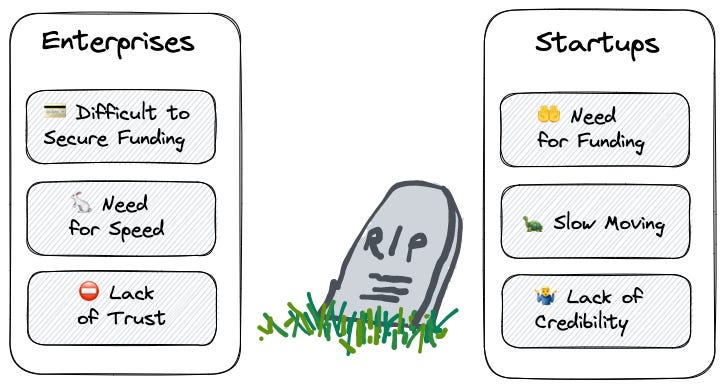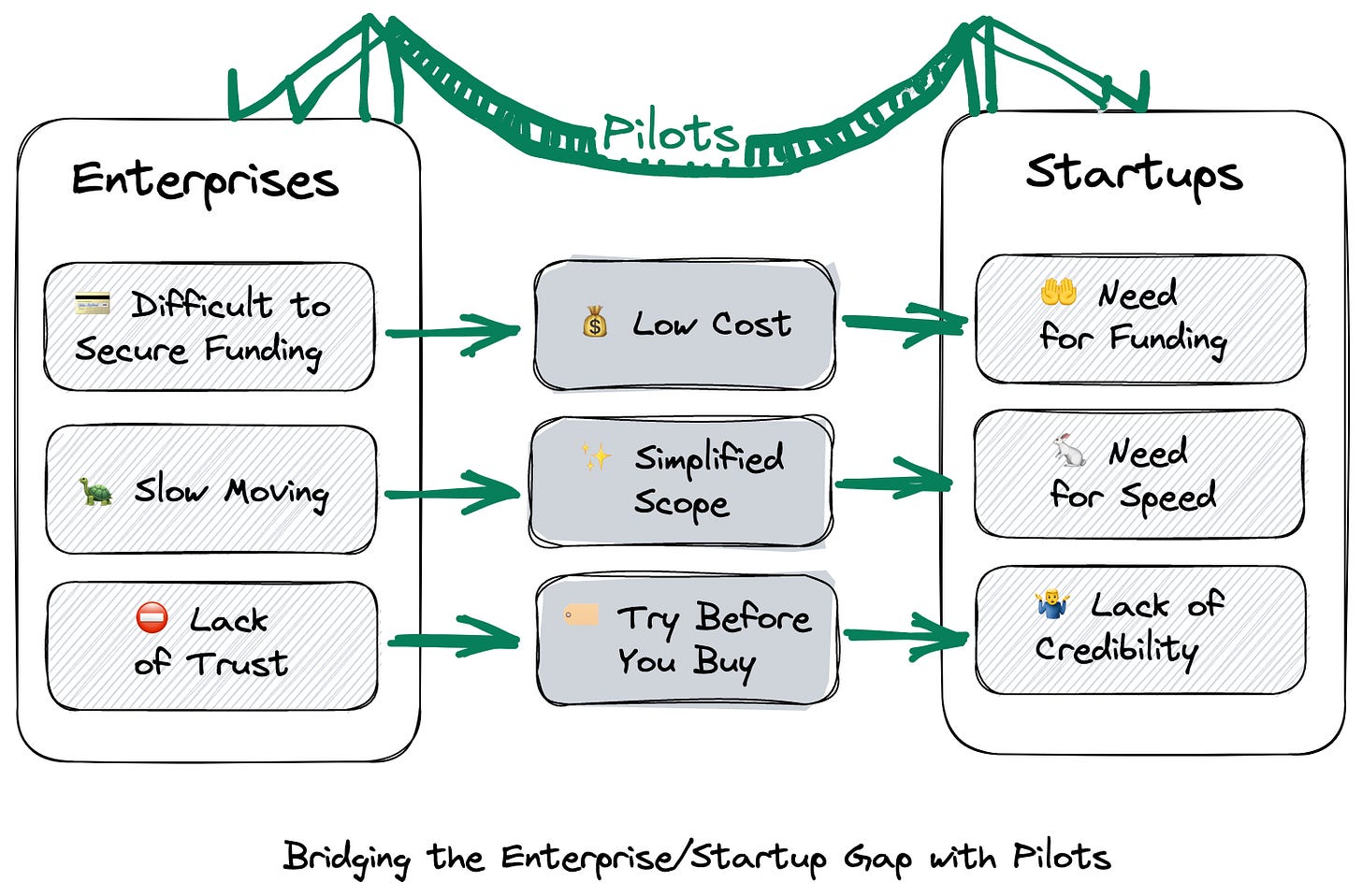Why You Should Pilot With a Startup
Why and where enterprises should look to startups for tech solutions
In addition to their core business function, large companies and enterprises have a lot of business-critical processes that typically rely on big, established, and trusted vendors to take on - think HR (ADP), accounting (Quickbooks), travel management (SAP Concur), Sales and CRM (Salesforce), etc. These large incumbents are stable and safe but that reliability comes at a cost. Because thousands of huge corporations depend on their uninterrupted stability, they back away from the innovation edge, and new features and improvements come slowly (if at all).
Unlike Enterprises that have millions of dollars in long-term contracts on the line if a new feature or product fails, startups have (relatively) nothing to lose and therefore can experiment and iterate at the speed of light. If they don’t innovate and launch quickly, they run out of money and disappear. They have a lot to prove in a short amount of time.
reliability comes at a cost…an enterprise’s trusted vendors have millions of dollars in long-term contracts on the line if a new feature or product fails.
As John Morhous, Chief Experience Officer at global travel company (and my startup’s acquirer) Flight Centre says, “Startups are able to adjust, pivot, and adapt their product far more quickly than large companies which have been critical in the travel industry over the last couple of years.”
Startups focus on acute but often ignored use cases
The big off-the-shelf vendors focus on and solve big core problems at scale well. Additionally, they solve many smaller, adjacent tasks reasonably well, and often ignore many tiny, edge-case issues entirely. It is these latter two cases that startups do well at, focusing all of their energy on acute but often ignored use cases and audiences. As Jake Saper, a VC at Emergence Capital recently said on the Acquired podcast, “The more obscure the job to be done or problem, the more opportunity there is for a unique insight.”
big off-the-shelf vendors focus on and solve big core problems at scale well. Additionally, they solve many smaller, adjacent tasks reasonably well, and often ignore many tiny, edge-case issues entirely.
The biggest example of a large incumbent in the enterprise corporate travel industry is SAP Concur; being a best-in-class expense management tool, a passable online travel booking tool, and not paying any attention to payment cards. These strategic travel choices left space for companies like TripActions (now Navan) to enter the market as a disruptive competitor, focusing on an underserved market in business travel (SMBs) with differentiated products; a user-friendly booking tool with a modern UI/UX, and a corporate credit card to capture expenses. And while some may argue they’ve lost some of their momentum, Navan’s approach of attacking the behemoth’s weak points (the booking tool’s UX) and focusing on underserved/ignored elements (SMB market and payment cards), they got masses of attention, funding, and initial customers.
Don’t try to replace a core vendor with an early-stage startup
As an enterprise, trying to replace a core vendor with an early-stage startup is not likely advisable (they probably won’t even know what an RFP is… I certainly didn’t). But, if your longstanding service provider has a gap in functionality that has been long-ignored, it’s time to go startup hunting!
if your longstanding service provider has a gap in functionality that has been long-ignored, it’s time to go startup hunting!
The problem is often the gap between your long, slow vendor process; the need for enterprise-grade security and processes; and lack of budget for new vendors, and the startup’s impatience; lack of credibility; and inexperience.
Below, I’ll map out the key categories of Enterprise Challenges, Startup Challenges, and identify how pilots, not procurement can close the gap:
Enterprise Buying Problems
The challenges buyers within a corporate department face come down to a slow-moving, spiraling web of complexity but I’m going to focus on three areas in particular; funding, speed, and trust.
Difficult to secure funding
Depending on the department, it can be very challenging to procure additional funding for a new, un-budgeted tool/use case. And even when funds are available, it’s hard to justify spending it on a small company that might not have the financial runway to even make it through procurement, never mind going live before they run out of cash.
Slow Moving
Enterprise procurement is notoriously—and usually justifiably—slow-moving. Due to the scale and complexity, corporate procurement can take months, if not years, to close a purchase.
Lack of Trust
Enterprises have armies of employees whose only job (okay, not only but it feels that way sometimes) is to say “no.” Teams like legal, information security, support, IT, and procurement must protect budgets, employees, data, and resources.
Startup Selling Challenges
Selling a new product, built by an unproven company without much capital into a large enterprise can be particularly difficult for the following reasons.
Need for funding
Startups need external funding to build products and grow competencies but external funding (angel investors and VCs) need to have faith and see traction in the team and product. Customers have to show interest in what’s being built for investors to fund it.
Need for speed
Startups often are operating with just months of runway (cash in the bank) and have to build a product, prove traction, and generate revenue in a relatively short amount of time or else they risk reaching the end of their monetary runway and fail before they realize their full potential
Lack of credibility
To raise funding or close customers, startups need to generate credibility by proving that other companies are willing to pay for the service (read: be the guinea pig) before most will sign up as customers or investors.
Bridge the Gap With a Pilot
This dichotomy needs a mechanism to bridge the divergent needs, incompatible timelines, and mismatched levels of sophistication. Enter the pilot or proof of concept project! Here’s why a pilot lets you test a startup’s ability to solve your problems without triggering the antibodies of corporate procurement.
Low Cost
By limiting the scope and commitment to test out a new product, the cost is dramatically lowered, and if the pilot is successful and you properly measure the state change (from before to after) and the ROI potential, getting the budget for a full purchase should be easier.
Simplified Process
With a smaller price, reduced user group, and limited timeframe, the process to start working with a startup should be simplified. Instead of going through a complex RPF process with multiple stakeholders, you should be able to present the startup with a simple Pilot agreement that only covers the scope of the limited project. I italicize “should” because if your company hasn’t worked with startups or done pilots in the past, they probably don’t have such agreements and may still try to get the startup to sign a full 40-page MSA. You should try to push back and come to a simplified version that’s more in line and commensurate with the dramatically lowered cost, commitment, timeframe, and risk that a pilot presents.
Try before you buy
Instead of (or in addition to) relying on others’ feedback and usage to validate the tech, you can be the trailblazing guinea pig and have the chance to not only try-before-you-buy but because you’re an early adopter, your feedback in shaping the product will carry much more weight and you can shape the product towards your job-to-be-done and end up with an even better solution than when you started.
Different from a trial or POC, a pilot should include the intent to make a full purchase if the pilot is successful while arming your decision-maker with proof to de-risk the decision. As an article in the Harvard Business Review (HBR) called The Stakeholders You Need to Close a Big Deal states, as the product’s internal “champion,” at the end of the pilot you need to “provide enough data, analysis, and outside validation to ensure that those who would question [the decision maker’s] decision see a trail of sound and thoughtful due diligence.”
Pilots provide a low-cost, low-risk mechanism for testing out new tech
In conclusion, startups are uniquely positioned to fill gaps in functionality that established vendors may ignore. While enterprise procurement can be slow and complex, pilot projects can provide a low-cost, low-risk mechanism for testing out new technology. By partnering with startups, enterprises can benefit from their agility and ability to iterate quickly. Through pilot projects, enterprises can de-risk the decision to make a full purchase by generating the data and analysis necessary to justify the investment. In today's rapidly changing business environment, it's more important than ever for enterprises to embrace innovation and look beyond established vendors for new solutions.
Pilot projects can provide a low-cost, low-risk mechanism for testing out new technology. By partnering with startups, enterprises can benefit from their agility and ability to iterate quickly.



